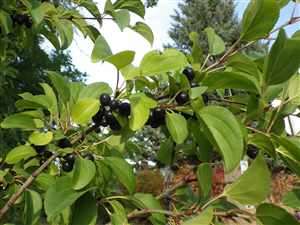Buckthorn (Rhamnus cathartica)
Main Facts about Buckthorn

Buckthorn is a shrub or small tree that reaches about 20 feet. It has shiny, dark green leaves and produces black, pea-size berries. It is not a garden plant.
Parts used – berries and bark.
Buckthorns may be confused with dogwoods, which share the curved leaf venation. The two plants are easy to distinguish by slowly pulling a leaf apart. Dogwoods will exude thin, white latex strings, while Buckthorns will not.
Buckthorn became popular in herbal healing in Europe around the 13th century. At the time, physicians believed that the key to curing disease lay in purging “foul humors”. Therefore, powerful laxatives were widely prescribed.
Using Buckthorn
Buckthorn is a powerful laxative that is usually recommended as a last resort, when other, gentler laxatives have failed.
Buckthorn contains chemicals called anthraquinones. They are very strong purgatives.
Don’t take Buckthorn for more than 2 weeks at a time. If you use it for too long, it causes lazy bowel syndrome, an inability to have bowel movements without chemical stimulation.
If you use bulk Buckthorn, be sure that it has been thoroughly dried. Otherwise, it causes vomiting, severe abdominal pain, and violent diarrhea.
Buckthorn infusion: ½ tsp each of dried Buckthorn, Fennel, and Chamomile (which soothe the stomach). Steep the blend in 1 cup of boiling water for 10 min, strain. Initially it tastes sweet, then – bitter.
Buckthorn is a remedy for: Constipation
| Broccoli |
Burdock
|